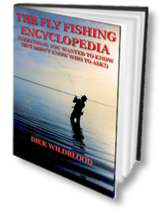
INTRODUCTION
BACK TO TABLE OF CONTENTS
Thank you for deciding to take the plunge! Like all things worth doing, fly fishing takes time to learn and master. But I'm going to radically reduce the time you take to become a proficient and competent fly angler. You'll save hours of frustration by learning the techniques I developed over the years that put fish in my net and trophies in my cabinet. Those techniques include casting methods and the easiest ways to learn them; fly fishing systems, and working out which one to use to match the conditions; fly types and how to use them - and tie them without pain and tears! You want to know about rods, reels, lines, leaders and all the other gear? It’s all in here. Much of what you read may seem to be common sense, but you will also come across the little gems of ideas that leave you saying to yourself "I never thought of that". . .
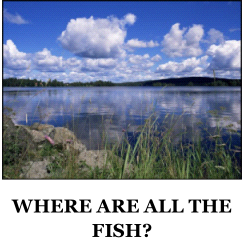 We've all done it - arrived at a fishing venue, whether it’s a reservoir, lake, stew pond, river or stream and wondered just where and how we are going to catch our fish. Gazing across acres of water there initially seems to be no clue as to where the fish are hiding. I once read an instruction book that merely said "Once you have located your fish, you can then decide the best way to present your fly". I don't know about you, but that seems less than helpful to me! Surely there should be some advice as to just how you are going to locate the fish in the first place. If that's the kind of advice you seek read on - this is what you've been looking for.
We've all done it - arrived at a fishing venue, whether it’s a reservoir, lake, stew pond, river or stream and wondered just where and how we are going to catch our fish. Gazing across acres of water there initially seems to be no clue as to where the fish are hiding. I once read an instruction book that merely said "Once you have located your fish, you can then decide the best way to present your fly". I don't know about you, but that seems less than helpful to me! Surely there should be some advice as to just how you are going to locate the fish in the first place. If that's the kind of advice you seek read on - this is what you've been looking for.
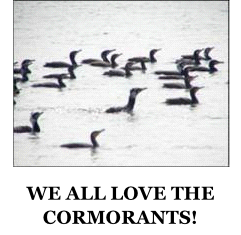 Trout live in a world where they are both hunter and hunted. We all imagine the carnivorous trout crashing through the shoal of fry, sending them scattering in all directions. It would seem to be the perfect hunter. But if you think that trout aren't really a prey species themselves, think again. I was once motoring across a serene piece of water in a hire boat on my way to the other side of the reservoir. Nothing appeared to be moving, not even a ripple. Suddenly there was a disturbance on the water that caught my eye. It was a cormorant breaking the surface. It took one look at my approaching boat and took to the air. That was immediately followed by another, then
Trout live in a world where they are both hunter and hunted. We all imagine the carnivorous trout crashing through the shoal of fry, sending them scattering in all directions. It would seem to be the perfect hunter. But if you think that trout aren't really a prey species themselves, think again. I was once motoring across a serene piece of water in a hire boat on my way to the other side of the reservoir. Nothing appeared to be moving, not even a ripple. Suddenly there was a disturbance on the water that caught my eye. It was a cormorant breaking the surface. It took one look at my approaching boat and took to the air. That was immediately followed by another, then 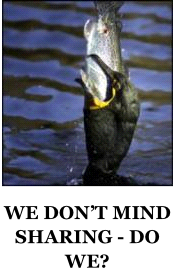 another and yet another. Within a minute I had counted one hundred and four cormorants where before there had been nothing but flat water. They had all been below the surface fishing for their dinner and the only thing on their menu was the carefully stocked and managed trout in the reservoir. And I have seen that same cormorant trying to swallow a trout that looked a good four pounds, only to give up and leave when it couldn’t get it down its throat – by which time the trout was dead, of course. Trout don't get it all their own way.
another and yet another. Within a minute I had counted one hundred and four cormorants where before there had been nothing but flat water. They had all been below the surface fishing for their dinner and the only thing on their menu was the carefully stocked and managed trout in the reservoir. And I have seen that same cormorant trying to swallow a trout that looked a good four pounds, only to give up and leave when it couldn’t get it down its throat – by which time the trout was dead, of course. Trout don't get it all their own way.
So here's the first lesson: trout spend their whole lives carefully balancing the needs of safety from their predators and the need to feed. When you begin to understand that balancing act you begin to understand where the fish are likely to be, why they are there and how to go about catching them.
There are many things to take into account that will influence this balancing act – the balancing act of where a fish will choose to be at any particular point in time. Not only will the trout have an escape route readily available, but it will also look for the greatest degree of comfort from its environment. Water temperature, water clarity, wind direction and strength, light intensity, weather conditions, perceived threats, food availability and the location of that food source - the list seems endless. You'll need to assess each element of this equation when deciding where your fish are most likely to be on any given day and at any given time. The following chapters will give you an insight into how all these pieces of the jigsaw fit together, until you reach a point when you'll be able to look at a stretch of water and almost instinctively know just where to wet your fly.
Unlike a hardback book, this Ebook/app is easily editable and is a constant “work in progress”. Any valid contribution that you want to make to this Ebook/app will be considered for incorporation into it so that other readers can benefit from your experience as well as mine. I've tried to make this Ebook/app as user friendly as possible and feedback on ideas for improvement are always welcome. You can also submit details of flies for inclusion in the galleries - a good photograph together with details of use, construction and material components are welcomed. I make no apology for using YouTube videos to enhance this publication - it would be impossible to create all the videos that were needed to make this a meaningful work.
This Ebook/app is of interest to anyone who wants to wet a fly, whether they live in New Zealand or Alaska, The Caribbean, the UK or any point in between. The basic techniques of fly fishing are the same for trout, salmon or salt water angling. This work can become even better with your help. Please feel free to email me with any information you would like to share on fly fishing locations that could be of interest to other readers. I would be happy to include the details in that section.
Any advertising found within this Ebook/app does not necessarily imply endorsement of those products although careful consideration has been given to the quality of advertiser. All copyrights are acknowledged and in particular I thank:
Ron at www.fliesonline.co.uk
Chris at www.flyfishingvenues.co.uk and
David at www.learnflytying.co.uk for their contributions.
That gets the formalities out of the way!
My first experience of fly fishing was quite by accident. Late one summer afternoon I found myself driving down a dual carriageway on my way home from a stressful business meeting. "AFTERNOON TEAS" proclaimed the road sign as I sped past. "Now that sounds like a nice way to wind down" I thought to myself. Ten minutes later I was lounging on a balcony overlooking an idyllic setting. Gentlemen of leisure were sitting in boats on a large expanse of water practising the ancient art of fly fishing. I was beguiled by the sight of such a wonderful way to spend an evening and was immediately smitten.
I have always been an angler, but of the coarse variety - even when I had lived in Canada I had used my coarse fishing techniques on the indigenous salmon and trout species. But fishing with a fly was a new adventure - an adventure that was to change my life.
I knew I had to give it a go. After all - as Jeremy Clarkson says - how difficult could it be . . .
I spent the next twenty years finding out just how difficult it could be! And the biggest problem I discovered was the reluctance of those with a little knowledge sharing their secrets with newcomers to the game. I gave up asking where or how a successful person had caught their fish. "In the water", "Out there", "With a fly" was the sort of unhelpful response I received. Perhaps they thought they were being humorous - but it certainly did not bring a smile to my lips! I now believe that many potential enthusiasts may have given up trying to learn the sport because they were also confronted by this unhelpful response.
You can't even be sure that the information you are given is accurate - I know of one seasoned angler, when asked the secret of his day's success, would always give the same answer, no matter what fly he had actually used or location he had visited. When I knew him well enough I asked him why he liked to mislead people in this way. "Well - we don't want other people taking all the fish and leaving none for us" was his reply. I’m sure there are lots of fly anglers who are willing to share information, but they seemed in short supply when I had a question or two. Besides, I often found that a lot of my fellow anglers had little more idea than I did - they would just chuck their favourite fly - and hope!
I read books and magazines on the subject and found these fall into two general categories. Firstly there are those that recount the author's exploits and adventures. This is very entertaining but not necessarily educational. Then there are those that give a guide on the equipment and hardware used in the sport. This is like describing the nuts and bolts of a car; it doesn't teach you how to drive! In one book I came across the informative advice "On a large water you must find the fish first either by asking local fishermen or looking for rising fish." You could stare at some waters for a month and never see a rising fish! And you already know my experience when asking other fishermen. There had to be better answers than these. So I set about teaching myself what others would not or could not share. I spent every moment - sometimes seven days a week - practising and working out the best methods. And now I'll share this knowledge with you.
Where to fish. How to fish. When to fish. What to use. Why the fish do what they do - you'll find it all in here.
There are sections on fly rods - what's good and what's not so good, reels and how to get the best out of them, fly lines and how to use them. There are over 150 videos to give even more depth to the information, along with dozens of hints and tips to help you become a successful and competent fly fisherman. There's a section on boat handling to keep you safe when you go afloat. And there’s even a section with dozens of recipes to help you cook your catch when you get it home!
But more important than all the technical stuff are the secrets on where and how to catch your fish. You'd be amazed at how many of those books I mentioned devote pages to special techniques and weird and wonderful ideas - but forget that the first question to answer is where, in all those acres of water, are you likely to find your elusive prey. It's no good fishing if the fish aren't there! I'll tell you where to find your quarry and, more importantly, why they are there, so you can translate that knowledge into a winning system you can apply to your own chosen water - wherever it may be.
There are galleries of flies so you can see what a fly looks like when someone mentions one you haven't heard of before. There's a section to introduce you to fly tying and dressing. And I'll show you the only three flies you're ever likely to need. I developed them from other patterns and can honestly say that I caught many of my fish using them. I couldn't buy these flies in the shops at the time so I developed some easy ways to tie them for myself and I'll show you how to do that quickly and easily. I even got into the habit of tying up a few flies over a cup of coffee just before I went fishing. That's how easy they are!
Most people get out fly fishing once or twice a month if they are lucky and never have the time to discover the techniques I perfected over the years. This book will give you the edge and save you hours of frustration. After all, fly fishing’s meant to be fun... remember? I spent much time and effort trying out different ideas so now you don't need to. I'll tell you how to recognise the best method for a particular time, season and weather conditions.
I recently read of one guide who is asking $244.00 - £155.00 per person for a day’s tuition. That’s nearly five hundred bucks for two people and that’s outside the budget of most of us these days. This was another reason why a do-it-yourself Ebook seemed to be more within the realms of affordability. And converting it into an app was the next logical step!
This Ebook/app is a voyage of discovery for the beginner and a source of information for the experienced fly fisherman, to share ideas and develop theories. I hope you enjoy it.
Dick Wildblood - 2013
DickWildblood@FlyFishingEncyclopedia.com
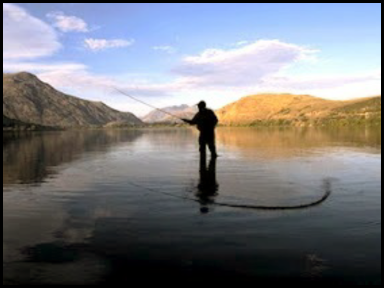
TABLE OF CONTENTS
